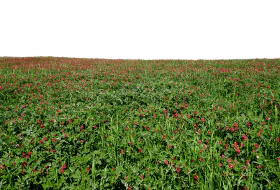Description
Forage seeds are essential for the cultivation of plants used in animal feed, especially in livestock systems. These plants include grasses, legumes, and other herbaceous species. Below are the general characteristics of forage seeds:
Shape and Size:
Forage seeds vary significantly in shape and size depending on the species.
Examples:
Elephant grass (Pennisetum purpureum): Small, oval seeds, measuring about 2 to 4 mm in length.
Ryegrass (Lolium multiflorum): Elongated and thin seeds, about 5 to 8 mm long.
White clover (Trifolium repens): Very small, spherical seeds, about 1 to 2 mm in diameter.
Alfalfa (Medicago sativa): Small, reniform seeds, about 2 to 3 mm long.
Colour:
The color of forage seeds can vary:
Tifton grass (Cynodon dactylon): Light brown to beige.
Brachiaria (Brachiaria spp.): Dark brown to black.
Red clover (Trifolium pratense): Yellow to light brown.
Cornichão (Lotus corniculatus): Light brown.
Structure:
The basic structure of forage seeds includes:
Bark (or integument): The outer layer that protects the seed.
Endosperm: The nutrient reserve that feeds the developing embryo, present in some seeds.
Embryo: The future miniature plant.
Weight:
The weight of forage seeds is quite variable. Small seeds, such as white clover, weigh only a fraction of a gram, while larger seeds, such as elephant grass, can weigh several milligrams.
Viability:
The viability of seeds depends on factors such as storage, humidity, and temperature. Well-stored seeds in proper conditions (cool, dry, and dark) can maintain their viability for several years, although most have a shelf life of 1 to 5 years.
Varieties:
Each type of forage has several varieties, adapted to different growing conditions and purposes of use. For example, there are many varieties of grass (Brachiaria, Panicum, Cynodon) and forage legumes (alfalfa, clovers, stylos).
Cultivation and Use:
Forages are grown in a variety of environments, from natural pastures to intensive cropping systems.
They are used for animal feed in the form of pasture, hay, silage, or green feed, playing a crucial role in the production of meat, milk, and other animal products.
Nutrient:
Forage seeds contain nutrients that are essential for the plant's early growth, such as proteins, lipids, and carbohydrates.
They are a concentrated source of energy for the developing embryo, ensuring successful germination and initial establishment of the plant.
Forage seeds are the basis for the production of plants used in animal feed, reflecting the diversity and importance of these plants in livestock and in the sustainability of agricultural systems.
- Forage seeds
Production Capacity:
Not informed
Delivery Timeframe:
Not informed
Incoterms:
CIF - Cost, Insurance and Freight
FOB - Free on Board
Packaging Details:
Not informed
More about
Agranda Global
0-10
Employees
500K - 1M
Sales volume (USD)
30%
% Export sales
Year
Established
Business type
- Industry / Manufacturer
- Representative / Agent
- Distributor / Wholesaler
Keywords
- seeds
- food
- sugar
- coffee
- grains
- rice
- beans
- soybeans
- corn
- Agranda Global Ver Mais
Contact and location
-
Juliana ********
-
+55 16********
-
Ribeirão Preto / SP | Brazil






